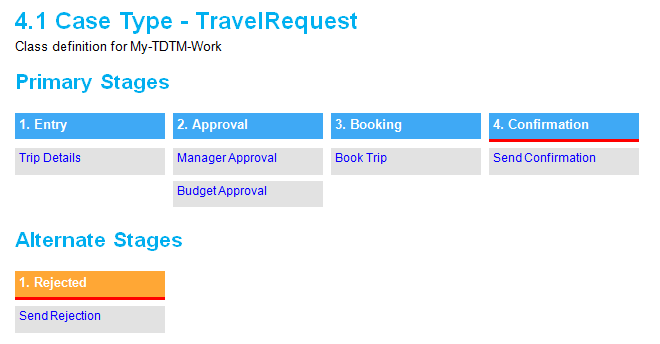Attachment support for requirements
Valid from Pega Version 7.1.6
Requirements now support attachments. You can add attachments from the Designer Studio > Application > Profile > Requirements landing page, the Add/Edit Requirement modal, or the requirement rule form.
Enhanced document generation
Valid from Pega Version 7.1.6
The following usability improvements have been made to documents generated by the Application Document Wizard:
- Stages and Processes now appear for case types that use Case Lifecycle Management. This diagram includes hyperlinks to corresponding sections in the document and is scoped to top-level processes only.

- All flows (excluding pyStartCase) referenced by a case type now appear in documents. This removes previous constraints on non-starting, draft, and checked out flows.
- Entity Relationship Diagrams (ERDs) are now embedded in documents as Visio objects.
- Sections without content are omitted from the generated document.
- Screenshots are labeled.
- Requirement text (Long Description) is included in the Requirements Matrix section.
- Linked requirements appear in context beneath their associated specification.
- Acceptance Criteria appears in context beneath the associated specification, report, or correspondence item.
PRServlet not required in PRPC URLs
Valid from Pega Version 7.1.6
PRServlet is no longer required in a URL when accessing PRPC. A URL typically written like this:
http://example.com/prweb/PRServlet?[QueryString]
Can instead be written like this:
http://example.com/prweb/?[QueryString]
Add additional columns to customized work history tables
Valid from Pega Version 7.1.6
The standard work history table, pc_history_work, contains two new columns that return the latitude and longitude coordinate location of the action that prompted the history. Mobile devices can display this location as a street address. If you have a customized work history table, add these two columns to it:
<decimal name="pxLatitude" size="19" scale="9"/><decimal name="pxLongitude" size="19" scale="9"/>
Enhanced date circumstancing option
Valid from Pega Version 7.2
The date range and as-of date circumstancing features have been merged into a single feature called date circumstancing. Accordingly, the new Property and Date circumstancing option provides more flexibility when you circumstance a rule. For more information, see Specializing a rule.
Renaming a system creates the required data requestors
Valid from Pega Version 7.2
When you rename a system, either from the System Name landing page or by updating the prconfig.xml file, any missing data requestors are automatically created by the Pega 7 Platform. The Data Admin System Setting is also created, if it is missing.
Configure Elasticsearch index nodes to ensure availability of index files
Valid from Pega Version 7.2
You can now configure Elasticsearch index host nodes in a Pega cluster outside of the Search landing page. This change ensures that search index files are always available by eliminating the need for manual configuration on the Search landing page. Use the new index.directory=<index_directory> command-line setting during JVM startup to indicate that this node is an index host node and to specify the directory where the index files will be hosted.
In addition, offline Elasticsearch index nodes can now be removed by using a new prpcUtils command-line option. For more information, see Managing Elasticsearch index host nodes outside of the Search landing page.
New Schema Tools and Query Inspector landing pages for Pega Cloud
Valid from Pega Version 7.2
Two landing pages have been added for advanced database administration tasks for Pega Cloud customers who use a Pega-hosted instance. These landing pages minimize the operations that need to be performed outside of the Pega 7 Platform. They are available only for customers who use a Postgres database.
From the new Schema Tools landing page, you can view PegaRULES and PegaDATA database schemas, increase the size of a column, add a composite or function index, update database statistics for a table, and defragment a table.
From the new Query Inspector landing page, you can enter an SQL query and generate an explain plan.
To use these landing pages, you must have the new PegaRULES:DatabaseAdministrator role. You access the landing pages by clicking or by clicking . The individual features that you can access are determined by the privileges that are assigned to you.
For more information, see Schema Tools and Query Inspector landing pages for tuning and maintaining databases in the Pega Cloud.
Custom properties can be passed to an Oracle database
Valid from Pega Version 7.2
You can pass a customizable set of property values to an Oracle database when a connection is established so that an SQL statement can be run. This feature provides the ability to implement object-level security for data access from a Pega 7 Platform application by defining Virtual Private Databases (VPDs) on class tables that reference the information passed. For example, you could pass in an operator's branch office into the context of every query run against the Oracle database to ensure that the operator has access only to data that is applicable to the operator's branch.
This feature is available only for Oracle databases and for a Data-Admin-DB-Name instance that is not PegaRULES or PegaDATA, and has the same connection metadata (JNDI, URL) as PegaData.
See Passing custom properties to an Oracle database.
Chrome support for editing specification descriptions in Word
Valid from Pega Version 7.2
If you use Google Chrome 42 and later, you can now create, save, and update specification descriptions even if you are not using the Microsoft Silverlight NPAPI plug-in.
The new option provides you with the functionality to upload a Word document that contains the specification description. In addition, you can use the option to export the description that you entered in the rich text editor to a Word document.

